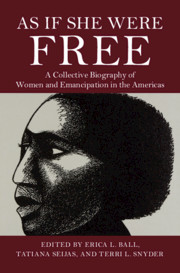Book contents
- As If She Were Free
- As If She Were Free
- Copyright page
- Dedication
- Contents
- Figures
- Contributors
- Elizabeth Catlett and the Form of Emancipation
- Acknowledgments
- Introduction
- Part I Claiming Emancipation during the Rise of New World Slavery
- Part II Experiencing Freedom during Slavery’s Expansion
- 7 Judith and Hannah: Eighteenth-Century Florida, South Carolina, and Virginia (US)
- 8 Sarah Chauqum, Eighteenth-Century Rhode Island and Connecticut (US)
- 9 Marion, Eighteenth-Century Natchitoches, Louisiana (US)
- 10 Anna Maria Lopes de Brito, Eighteenth-Century Minas Gerais (Brazil)
- 11 Juana Ramírez, Eighteenth-Century Oaxaca, New Spain (Mexico)
- 12 Juana María Álvarez, Eighteenth-Century New Granada (Colombia)
- 13 María Hipólita Lozano, Eighteenth-Century Lima (Peru)
- Part III Envisaging Emancipation during Second Slavery
- Part IV Enacting Emancipation in the Aftermath of Slavery
- Bibliography
- Index
9 - Marion, Eighteenth-Century Natchitoches, Louisiana (US)
from Part II - Experiencing Freedom during Slavery’s Expansion
Published online by Cambridge University Press: 24 September 2020
- As If She Were Free
- As If She Were Free
- Copyright page
- Dedication
- Contents
- Figures
- Contributors
- Elizabeth Catlett and the Form of Emancipation
- Acknowledgments
- Introduction
- Part I Claiming Emancipation during the Rise of New World Slavery
- Part II Experiencing Freedom during Slavery’s Expansion
- 7 Judith and Hannah: Eighteenth-Century Florida, South Carolina, and Virginia (US)
- 8 Sarah Chauqum, Eighteenth-Century Rhode Island and Connecticut (US)
- 9 Marion, Eighteenth-Century Natchitoches, Louisiana (US)
- 10 Anna Maria Lopes de Brito, Eighteenth-Century Minas Gerais (Brazil)
- 11 Juana Ramírez, Eighteenth-Century Oaxaca, New Spain (Mexico)
- 12 Juana María Álvarez, Eighteenth-Century New Granada (Colombia)
- 13 María Hipólita Lozano, Eighteenth-Century Lima (Peru)
- Part III Envisaging Emancipation during Second Slavery
- Part IV Enacting Emancipation in the Aftermath of Slavery
- Bibliography
- Index
Summary
In 1757, officials in Fort St. Jean Baptiste at Natchitoches, Louisiana initiated a criminal investigation to look into the theft of textiles and other goods stolen from French settlers. According to the court record, the accomplices in the robbery were all working under the direction of an enslaved woman named Marion who deployed goods both as a business (which spanned French and Spanish settlements), and as a form of patronage. The scale and brazenness of her commercial activities expands the definition of freedom. Marion secured an impressive measure of autonomy all the while remaining legally enslaved. Her freedom may well have been relative, temporary and impermanent, yet for an unspecified number of years she succeeded in establishing herself as a formidable entrepreneur with liberty to trade between French and Spanish settlements, and with authority over many others, both slave and free. While her reign lasted, she made room for enslaved men and women in Natchitoches, and some free ones, to earn additional funds, to procure and design apparel to their own taste, and to feast with conviviality on beignets, grilled chicken and wild game washed down with suitable libations.
- Type
- Chapter
- Information
- As If She Were FreeA Collective Biography of Women and Emancipation in the Americas, pp. 171 - 189Publisher: Cambridge University PressPrint publication year: 2020
- 1
- Cited by

